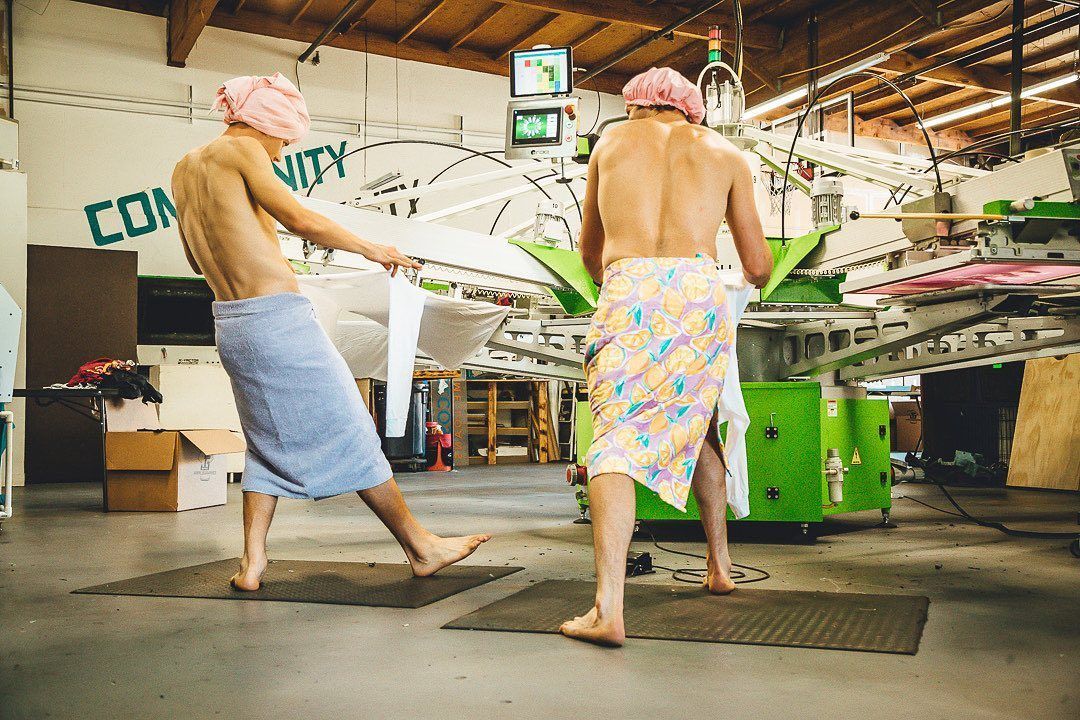How do you know if a print shop you’re going to partner with is worth trusting? What really matters when you choose a print shop?
If you want to partner with a print shop, you should know that Printavo has worked with 3,000-plus print shops of all sizes that do all kinds of decoration techniques.
We’ve seen that there’s no secret formula for success—small, medium and large print shops all provide tremendous value for the right clients.
But in the past few years, we’ve noticed some strong signals that print shops send. They’re signals you can pick up on just by walking in the front door and looking around their facility.
We’ll tell you the big red flags to look out for … and the small but important signs of quality that are impossible to ignore.
Ask to visit the shop
If it’s not too long of a trek, always ask to visit the shop you’re planning to partner with.
If they turn you down or seem really hesitant to host you in their shop—that’s a major red flag. Most shops will accept you with open arms.
Touring the shop gives you the opportunity to take in a lot of details. But the details aren’t always what matter. You’ll have an intuitive sense of what kind of business it is from the moment you walk in.
Is it clean? Are the people happy? Does it seem chaotic—or organized? Is the pace relentless, slow, or just right? Does this feel like the kind of business you want to be part of, even if only indirectly?
Nothing beats visiting when you’re making this decision.
Due diligence: They do what you want, when you want it
The most basic due diligence you can do is to check that the shop you’re going to partner with. Ask them if they:
• Can get the brands and products you want to sell. If they work with different wholesalers, promo companies, or brands—you may want to reconsider.
• Can do the decoration techniques you need. If you’re asking them to learn a new technique, beware! Lean on experience.
• Work with clients similar to your own—or you. If you’re a totally new type of client or are seeking a service the shop is just learning, they may not be the optimal partner.
• Are in shipping lanes that are one to two days from you or your clients. Don’t get into a turnaround crunch by using a shop that’s too far from you.
• Have a known track record with referrals. If the shop won’t show you samples or referrals, look out! That’s a red flag.
• Has a price point you can utilize. Don’t be overly price sensitive—but make sure you’re still turning a profit and meeting the price point that your customers like.
We mention this not because it’s something you’d forget—but because this kind of checklist is great for gut-checking any new partnership.

Cleanliness matters
If you visit a shop and it’s dirty—covered in lint, ink, garments, and chaotically disorganized—that’s an obvious red flag.
“A clean shop shows that the workers have a sense of pride in what they do,” explains Brett Bowden of Printed Threads in Ft. Worth, Texas.
Ink and garments should be separate. Machines should be clean and well-maintained. The best shops have HVAC systems so that they can achieve consistent results—as variations in temperature and humidity impact screen printing quality considerably.
The facility should be well-lit, laid out so that workers have ample space, with no fumes or smoke from curing ink in the printing area.
Happy people matter
What does the staff seem like? Are they happy to be there—or does it feel more like a sweatshop? Custom printing is hard work, and it’s not always sunshine and roses in a print shop.
But even the hardest working teams develop an affinity for their work when they take pride in it and are allowed to do the best they can.
One of the biggest red flags is simply unhappy staff. “When I visit a shop and people seem sort of afraid of the owner, not making eye contact, that worries me,” Ryan Moor from Ryonet told us.
The staff are who you rely on to execute your vision—if they’re engaged, happy, and valued, there’s lower turnover and your relationship doesn’t rely on temp workers or disgruntled employees.
Written procedures and standards matter
Want to know what really separates the professional print shops from the semi-pro and amateur shops?
The biggest and most successful shops have standard operating procedures for every single part of their operation—from order intake to screen making to printing to checking ink to make sure it’s totally cured.
Ask to see any standard procedures they use for printing. Are they detailed, up to date, and usable—or does the shop seem like they simply wing it?
If you want to dive into specifics, some good questions are:
- What is your spoilage rate (1-3% is standard) and how do you handle spoilage?
- How do you handle misprints or art problems?
- Do you allow press checks?
- How do you handle delays or shortages?
Another simple quality check is to ask to see the shop’s MSDS (material safety data sheets)—this shows an attention to detail that many shops simply don’t have.

Ask to see the shop’s best work
Great shops are always proud of their best work. If they can’t supply examples of their finest work—jobs they’re proud of that show off technical prowess or some other skill set—this is a huge red flag. Look for colorful, precise, and frankly beautiful prints and designs on a variety of substrates.
If the shop specializes in work that is far outside of your niche, they may not be a great partner for you. Inspecting a shop’s finest work lets you understand what the shop excels at and what they like to focus on. You don’t want to send a shop that specializes in intricate animated prints a lot of embroidery work, for instance.
There’s another bonus to seeing the shop’s best work: it’s inspiration. The shop’s portfolio can tell you a lot about what they like to do, how they do it, and what you could collaborate on together.
The detail test
While some might consider this a bit of a devious tactic—it’s a great test of the shop’s ability to keep up with detail. When you get in touch with the shop, make some very specific demand: For instance, ask that you be contacted through an email with a specific title.
“Please reply with the email title ‘SHOP PARTNER’ to ensure it goes to the right person”—this kind of simple test can tell you a lot about how the shop handles detailed requests and whether you can count on them to read and listen to your needs.
The X factor: the ‘beautiful dance’ and the drive to improve
The division between a great print shop and a totally average one often comes down to two things:
1. The people in the shop are part of a “beautiful dance.” It may be busy and chaotic, but it’s never stressful or disorganized. They move fast and know where they need to be. It’s more like a fast-moving kitchen than a print shop. They thrive on this energy and make the most of the activity.
2. The people in the shop are always looking for ways to improve. They actively seek improvements to process, technique, and customer management. The shop itself is constantly under evaluation—they’re not resting on their laurels, but take an aggressive posture toward becoming better as a business.
These are the “X factors” that really come down to culture in the shop. It can’t be faked.
When a shop has low employee turnover, a dedicated staff and ambitious leadership, you’re far more likely to have a successful partnership.
Look for the signs of quality. Trust your gut. Visit if you can. Picking the right print partner doesn’t have to be a nightmare!



